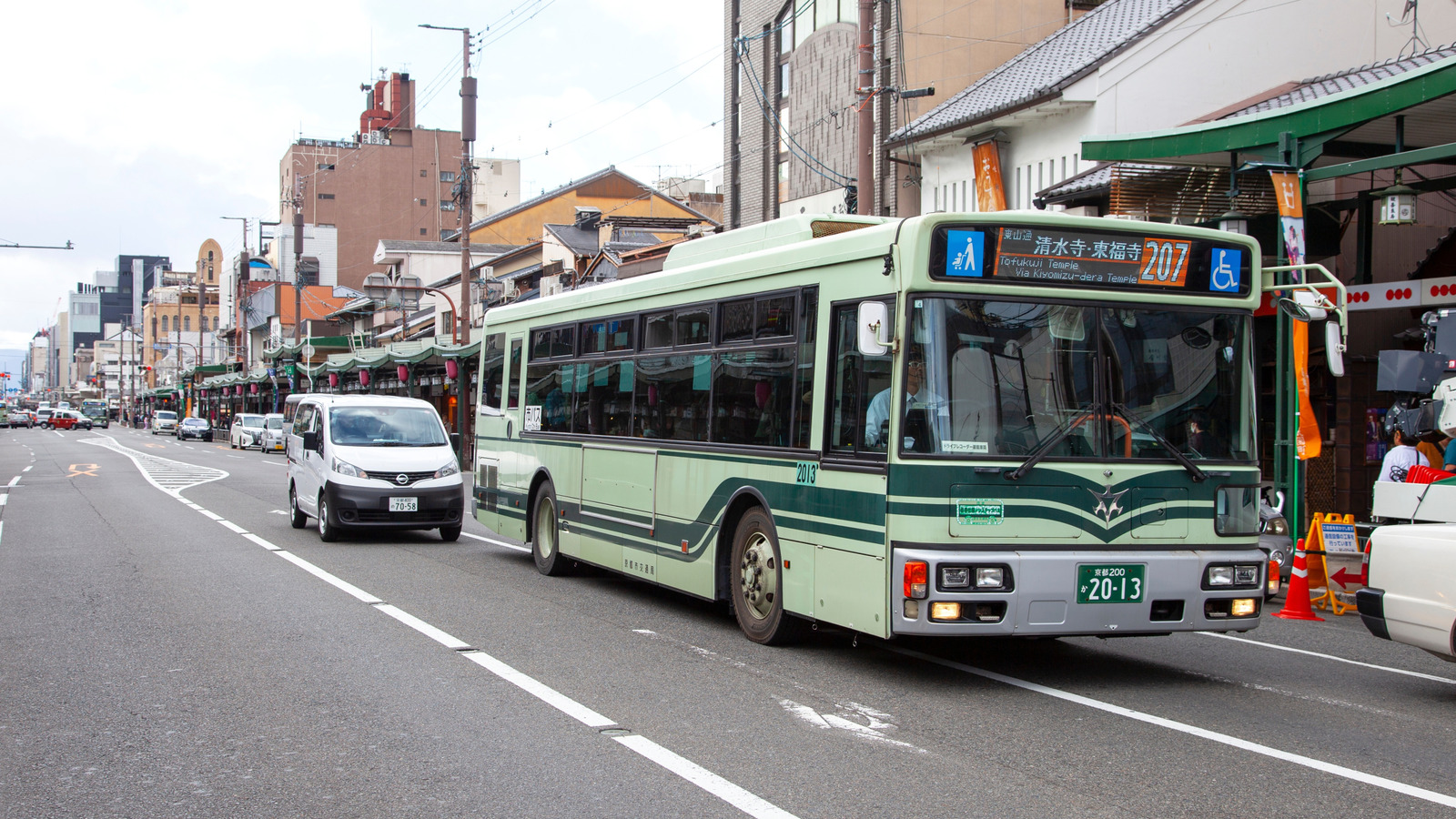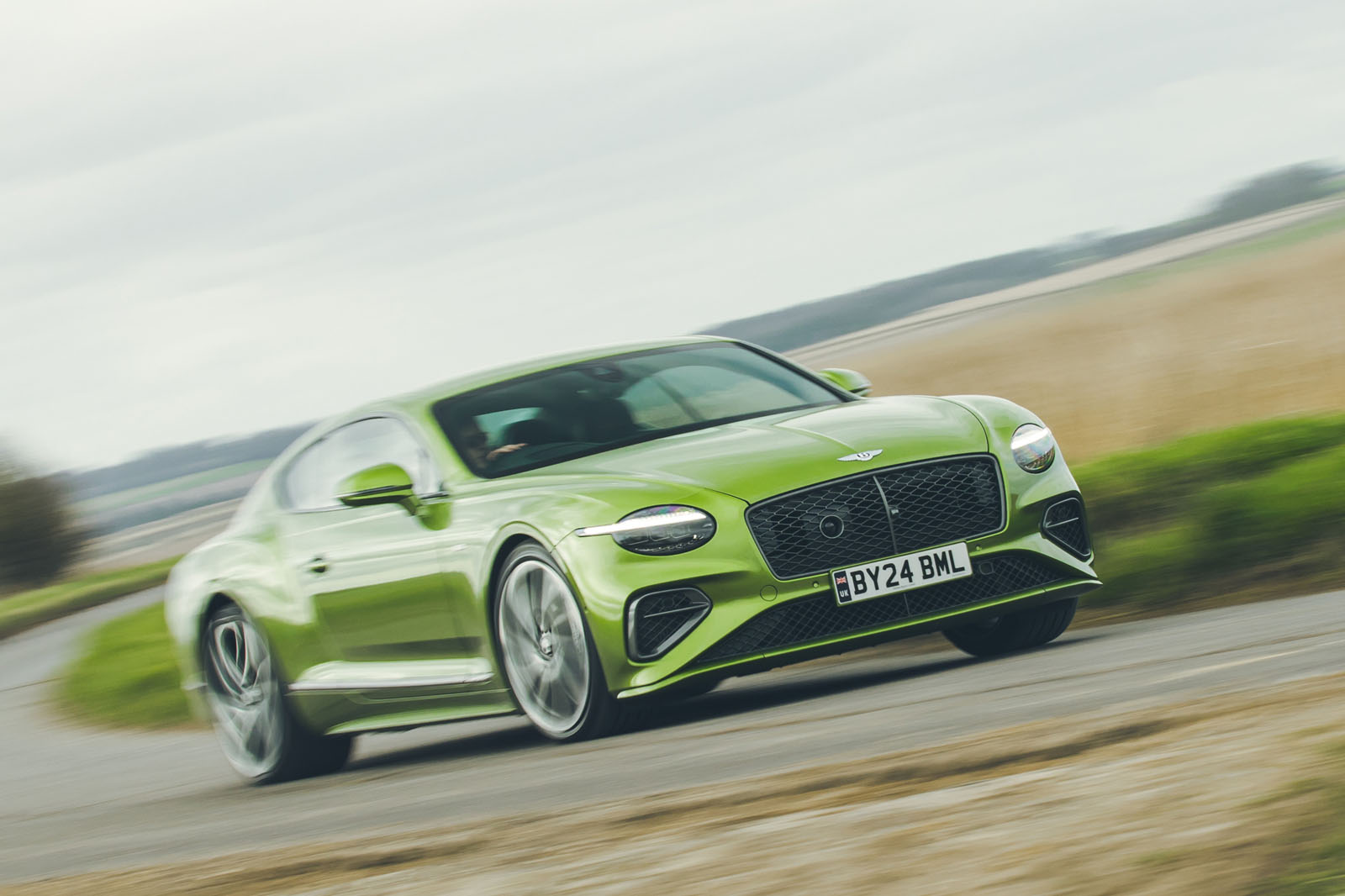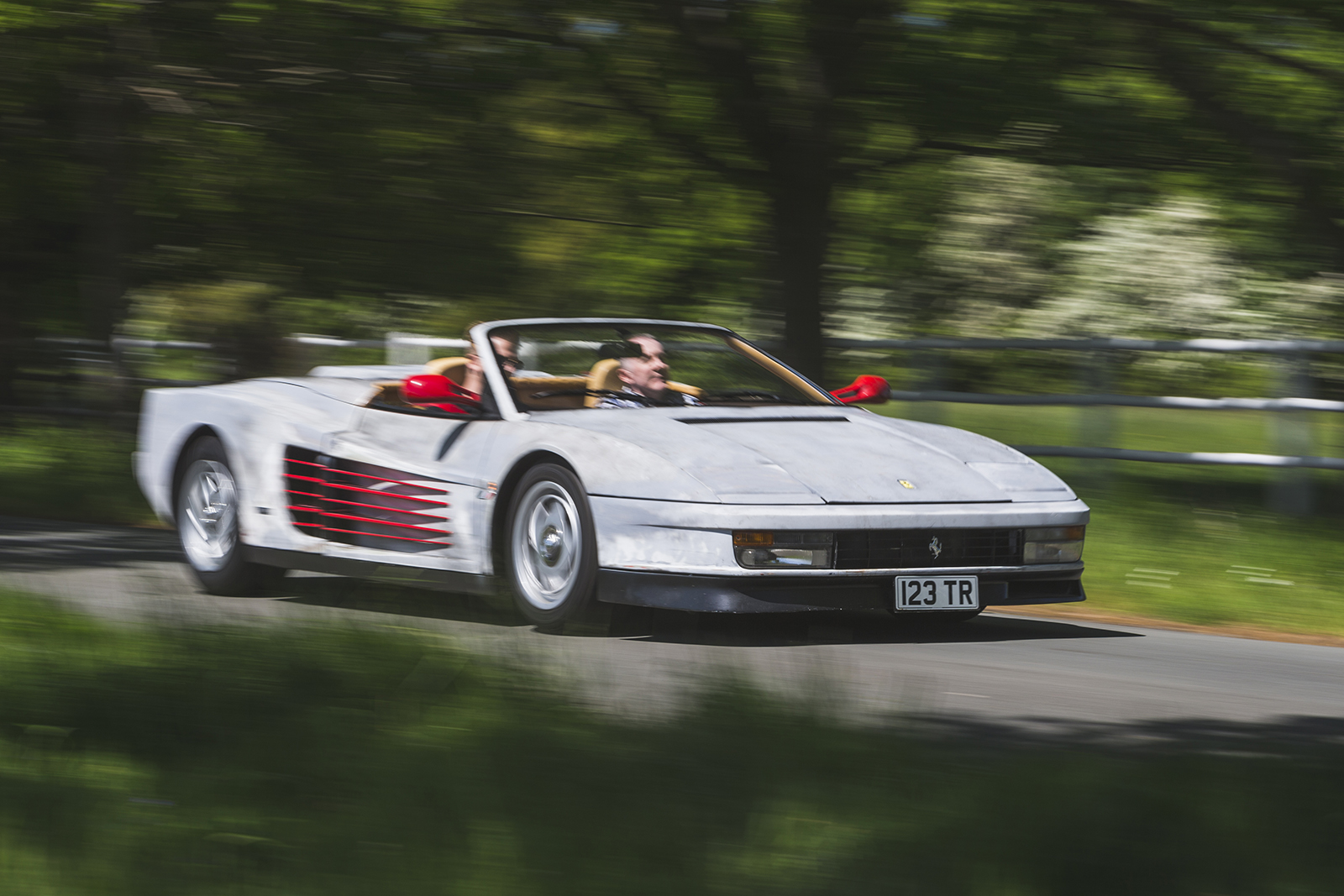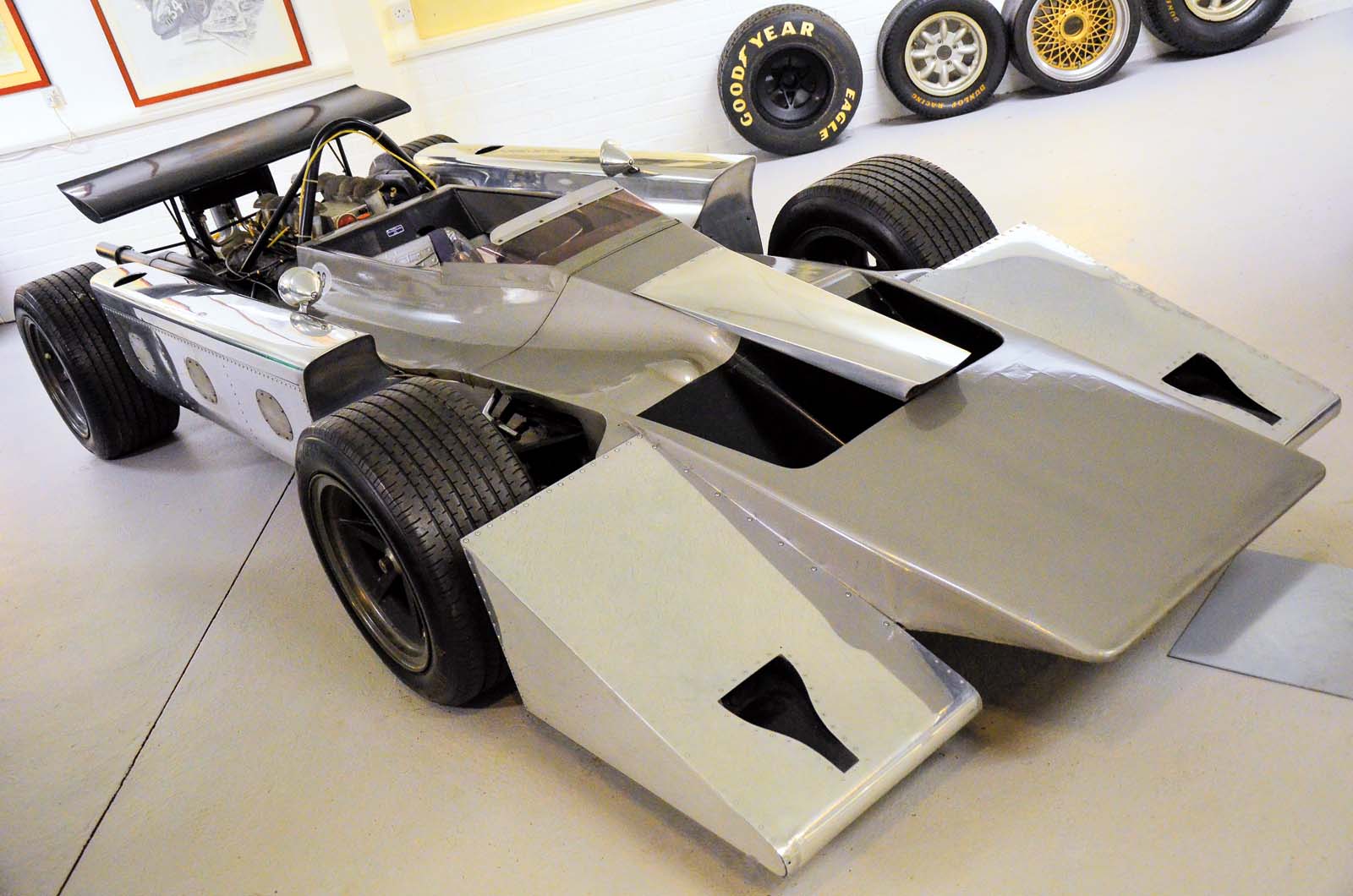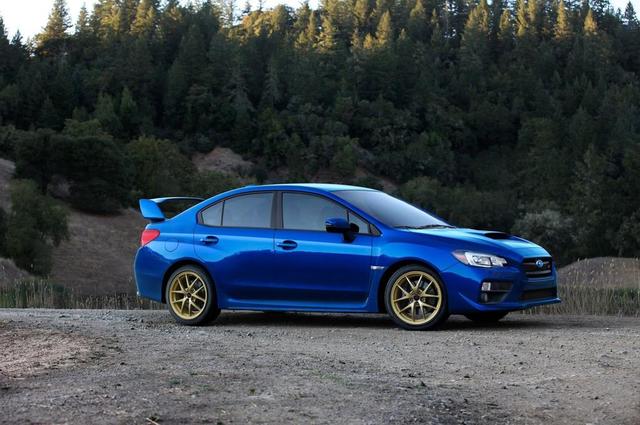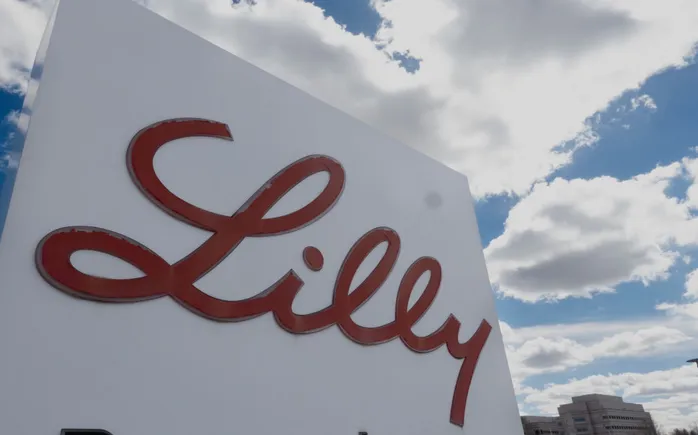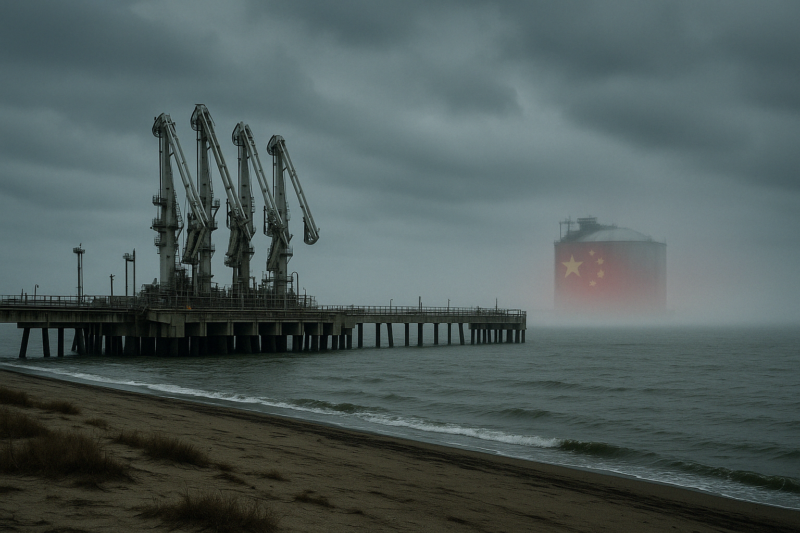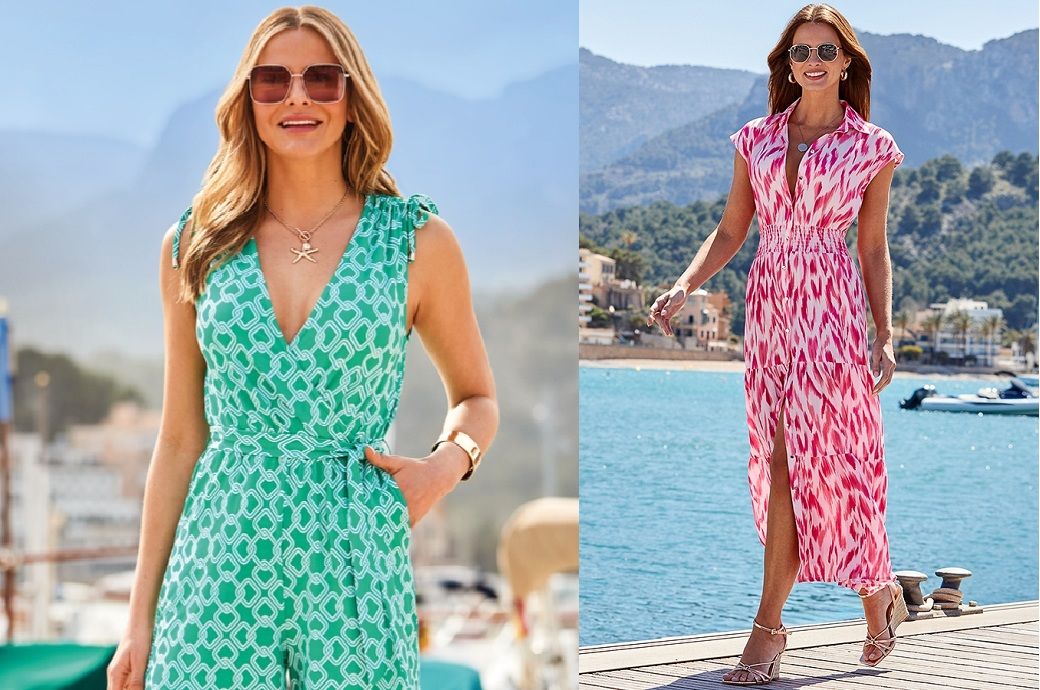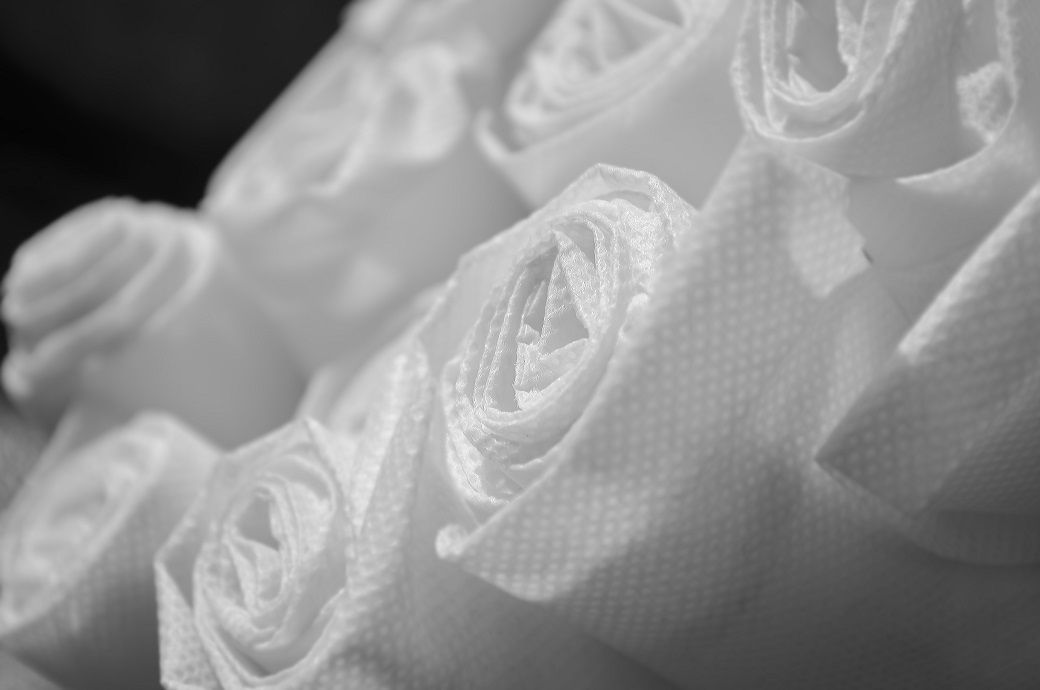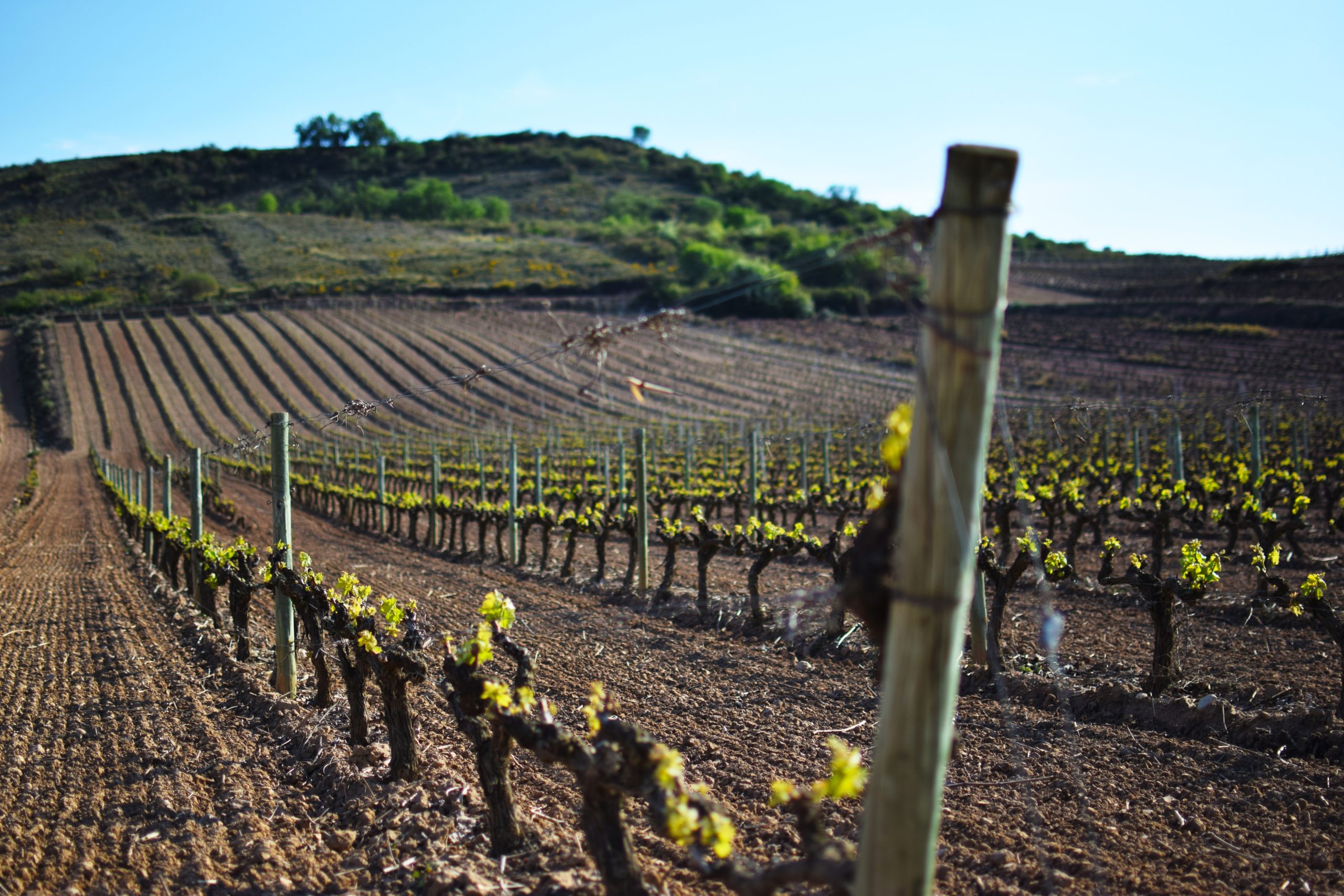Douglas Blyde stops off at Victor Garvey's new eatery at The Midland Grand in St Pancras and ponders whether "coherence may be overrated" in restaurants.
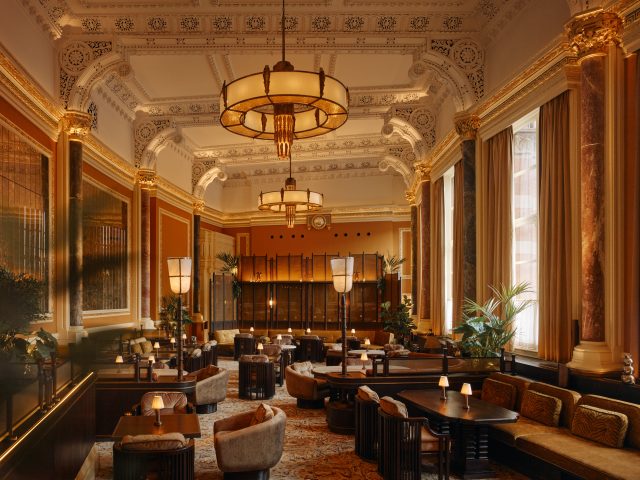
Some restaurants creep into historic buildings like guilty mistresses. Not this one. Victor Garvey at The Midland Grand sprawls across its dining room like a dandy on a chaise longue, asking what vintage you’ve brought to please it. Its home, St. Pancras Chambers, is Victorian ambition in stone – the lovechild of a Gothic cathedral and a rococo opera house, built to dispatch trains and impress men with handlebar moustaches.
Conceived in 1865 by George Gilbert Scott as the Midland Grand Hotel, it was a station with delusions of Versailles: Minton tiles, gold-leaf ceilings, and that staircase - coiled like a peacock’s tail. Among its novelties were Britain’s first lifts – “Hydraulic Ascending Rooms” – so unnerving that sherry was served on every landing. One moment in the lobby, the next airborne, half-pickled and staring into the face of modernity.
Impressive, but unplumbed. Hip baths were wheeled to smoky fireplaces. Too beautiful to function, too costly to fix, it closed in 1935. Then came the descent: five-star glamour to railway digs to British Rail offices. A mezzanine was even hacked into the dining room – vandalism - the scars still visible in the soaring pillars.
Salvation came via Sir John Betjeman’s poetic pleading, followed by a restoration so lavish it might have bankrupted a minor duchy. Its cultural moment? The Spice Girls dancing on the grand staircase in Wannabe – arguably the most exuberant use of Victorian masonry since Victoria flicked the gas on.
Now Garvey arrives, staging haute cuisine in a room already thick with the ghosts of Marcus Wareing and Patrick Powell. Tim Hayward called it “determinedly sensuous”.
Hot Dinners noted a pivot. Harden’s traced Garvey from Barcelona to Beverly Hills. And then, inevitably,
OpenTable’s “Sarka” moaned about the lighting, pacing, and absence of a non-alcoholic pairing – like sitting through
Hamlet and demanding your money back because Claudius lacked seasoning.
Drinks
The list, composed by Kurdish-born, Seyit Ali, formerly of Claridge’s and now long-serving here, opens with a nod to Blighty: 2019 Rathfinny Classic Cuvée (£15/125ml), from a vintage which, as
Grape Britannia put it, “narrowly dodged a couple of bullets". At the other end: the opulent 2013 Rare (£45), for those who prefer their bubbles with more drama and dosage.
Rathfinny continues to wave the local flag by the bottle, though a building of this pedigree, designed by the man behind the red telephone box, could comfortably host more homegrown names alongside. Champagne becomes compelling around the £200 mark, with Mouzon Leroux’s 2016 L’Ineffable Blanc de Noirs (£195) being a name which overdelivers for a competent Grand Cru. Krug Grande Cuvée 166ème (£455) is, by capital standards, modestly priced, though still dear enough to make one consider who deserves to drink it with you.
Still wines swing from terminally pleasant to properly juicy. By the glass, Centenaire, Domaine Lafage, Côtes Catalanes (£9) is all sun, no shadow: charming, forgettable. Thanks to Coravin, 2007 Torbreck Descendant (£43) is available, delivering brilliantly beefy, oaky New World largesse.
At the bottom of the cellar, Domaine de Ménard Cuvée Marine (£34) is about as exciting as mineral water. At the top: 2004 Ruchottes-Chambertin Grand Cru Clos des Ruchottes by Armand Rousseau (£2,090) may provoke veneration or simply raise questions about whether Burgundy’s pricing has become a long-running joke.
The fruitful middle – £50-£65 – is where things stir: 2021 País Volcánico (£59) offers funk and volcanic intrigue; 2022 Olifantsberg Roussanne (£63) shows South Africa hasn’t realised it’s supposed to be expensive.
Over £100 brings confident pours: 2020 Quintodecimo Falanghina (£110), a Mediterranean Chablis in bespoke tailoring; 2012 Sociando-Mallet (£105), the Bordeaux which has been “about to be discovered” since the iPod; and 2017 Gramercy Cellars Syrah (£115), more Broadway than Rhône, but enjoyable nonetheless.
The sweet section is lush: 1994 Warre’s Vintage Port (£175) is serious, structured. A half bottle of Noé 30-Year-Old Pedro Ximénez (£75) is all drama, sticky, ancient, and travelling at the speed of custard.
At Gothic Bar, cocktails come with names like “Temptation”, collaging orange wine, Suze, Glenmorangie 10 (increasingly rare). There’s also the X Muse Martini: Scottish heritage barley vodka pepped with olive eau de vie, described by the bartender as “a clean dirty Martini".
Dishes
Dinner was cooked in Garvey’s absence – he was at the funeral of the family cat, which coincidentally happens to be the name of the band Enotria Coe’s John Graves was the bassist in. Pairings were playlisted by Ali, who declared: “Wine and food are dance partners, and your palate is the stage.”
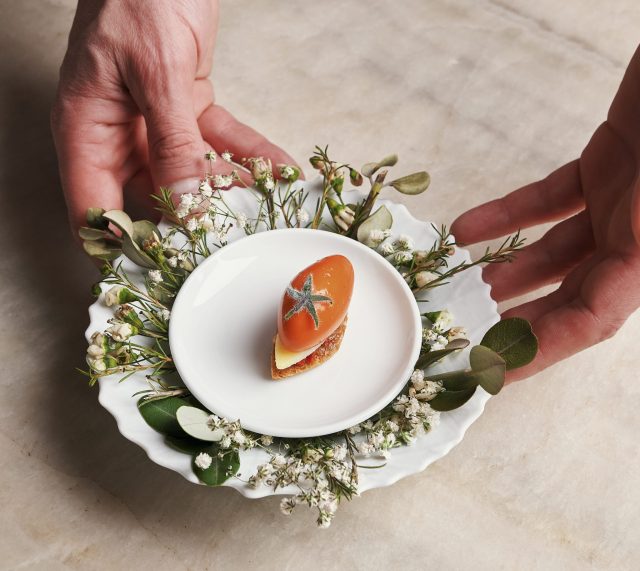
The amuse-bouches, collectively titled Le Jardin Méditerranée, arrived as a vignette of delicate conceits, wielded incongruously with a spoon better suited to soup kitchen ladling. A tomato gazpacho, christened in honour of Belgian chef, Gert De Mangeleer of the three-star Hertog Jan, perhaps betrayed Garvey’s own Michelin aspirations. The liquid itself was splendid - direct and precise - though its compressed tomato base proved surprisingly unyielding. More successful was a trompe l’oeil pissaladière masquerading as a black olive, a witty nod to Nice via El Bulli. Ali paired it with Birgit Eichinger’s Grüner Veltliner – silky, summery, labelled with a tipsy portrait of the winemaker. She had, he noted, visited on International Women’s Day – presumably not to eat the bread, which was pale, timid, and served with butter so saltless it may as well have been moisturiser.
La Sériole followed - belly and loin of sashimi-grade yellowtail, the latter wrapped in crisps which tasted faintly of salt and vinegar, with avocado, leek, and a note of elderflower which gave it the air of a picnic in a Japanese garden. The wine, Vincent Pinard’s Flores, was an oaked Sancerre - polished and textural. It confirmed that Ali’s pairing style leans toward the elegant and non-combative, which works until you realise Garvey’s food is itching for a brawl - complex, layered, often confrontational.
Then, foie gras through a David Cronenberg lens: lurid, pink, glistening. Segments of duck liver, marinated in ice wine and Madeira, mosaicked and wrapped in what the server called a “raspberry gilet” and oxalis. Sweet, alcoholic, intense. Presented with a star-shaped brioche (another wink at Michelin), it was oddly mesmerising. The pairing – Fritz Haag’s Juffer Riesling – was light, faintly sparkling, and raspberry-friendly, but too polite for such a dramatic dish.
Le Torteau brought order. A perfectly timed dish of Cornish rock crab with sweet pea, smoked eel croquette, seaweed vinegar and jalapeño foam - was the clearest, most resolved idea of the night. Woodland meets shoreline. The wine: Petritis, from the Cypriot winery Kyperounda - high-grown vines (1,240m) and a crisp, resinous finish. The pine cone on the label felt appropriate, if a little on the nose.
Another Cornish turn: lobster tail with sand carrot, apricot and osmanthus. It came with 2023 Roubine rosé, Premier Cru Classé since 1938 – charming, safe, smoky. An orange wine might have added welcome friction. A flambéed boudin in coconut bisque with lemongrass showed assurance – properly cooked, properly cocky.
Then turbot, “ikejime”-dispatched – a Japanese method involving swift spinal severance to preserve purity of flesh. Love, our waitress, newly arrived from Chiltern Firehouse and still reeling from an early fire alarm here, admitted she didn’t know the term, despite its place on the menu - a small lapse which mirrored a wider disconnect between kitchen and floor. The fish was well cooked, but the promised truffle was absent. Alongside, a solitary tortellino of duck liver and turbot skirt, in soy-liver reduction with ginger, belied its description by the server who said “it’s a thingy” while Ali called it “French ramen”. A rubbery quail egg dulled the effect. The meticulous wine – Vigna di Gabri, a fridge-cold Sicilian blend of five grapes – was aromatic in theory, though a red, served with nerve, would have worked harder.
L’Agneau was a pink cutlet with a dot of herb mousse, served with 48-hour lamb breast, Guernica pepper and Breton beans. A red finally appeared - 2019 Saint-Joseph from André Perrin - smooth, if shy.
Le Pamplemousse, the pre-dessert, took aeons to prepare. Grapefruit presented in multiple textures - sorbet, jelly, jus - with rosemary, and paired with Brachetto d’Acqui from Contero, unveiled from Ali’s double-breasted jacket like a magician producing a rabbit in sequins. Unfortunately, the wine was warm by the time the dish arrived, and what should have been refreshment turned into a flabby cordial.
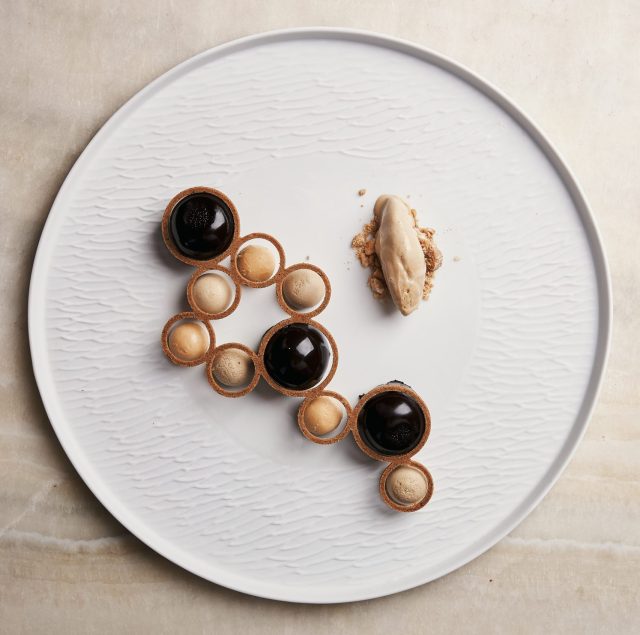
Finally, L’Opera: coffee from the Geisha “Elida” lot, cep, 80% bean-to-bar chocolate, almond, Armagnac, five-spice tuile - arranged like molecular gastronomy circa 2008. Too much, too late, yet a masterful dish. The 2009 Rivesaltes Ambré was a fine closer – treacly, nutty, like sipping a walnut in mourning dress.
Last sip
The food is clever, constructed, occasionally arresting – though service misses its cues and the wine, at times, seems to be performing in a different production. Garvey may have been absent – offstage for a feline requiem – but his presence lingers: in the bravura, the eccentricity, the unembarrassed theatricality of the thing. No, it isn’t seamless. But in a city where menus are written by committee and restaurants are designed to offend absolutely no one, coherence may be overrated. Would you rather be flattered or disoriented? Remembered or forgotten?
Best for
- Sparkling wines trolley
- Chef’s table
- Attention to ingredients
Value: 92,
Size: 93,
Range: 94,
Originality: 94,
Experience: 91;
Total: 92.8
St Pancras Renaissance Hotel, Euston Rd., London, NW1 2AR; 020 7341 3000; midlandgranddiningroom.com

 Some restaurants creep into historic buildings like guilty mistresses. Not this one. Victor Garvey at The Midland Grand sprawls across its dining room like a dandy on a chaise longue, asking what vintage you’ve brought to please it. Its home, St. Pancras Chambers, is Victorian ambition in stone – the lovechild of a Gothic cathedral and a rococo opera house, built to dispatch trains and impress men with handlebar moustaches.
Conceived in 1865 by George Gilbert Scott as the Midland Grand Hotel, it was a station with delusions of Versailles: Minton tiles, gold-leaf ceilings, and that staircase - coiled like a peacock’s tail. Among its novelties were Britain’s first lifts – “Hydraulic Ascending Rooms” – so unnerving that sherry was served on every landing. One moment in the lobby, the next airborne, half-pickled and staring into the face of modernity.
Impressive, but unplumbed. Hip baths were wheeled to smoky fireplaces. Too beautiful to function, too costly to fix, it closed in 1935. Then came the descent: five-star glamour to railway digs to British Rail offices. A mezzanine was even hacked into the dining room – vandalism - the scars still visible in the soaring pillars.
Salvation came via Sir John Betjeman’s poetic pleading, followed by a restoration so lavish it might have bankrupted a minor duchy. Its cultural moment? The Spice Girls dancing on the grand staircase in Wannabe – arguably the most exuberant use of Victorian masonry since Victoria flicked the gas on.
Now Garvey arrives, staging haute cuisine in a room already thick with the ghosts of Marcus Wareing and Patrick Powell. Tim Hayward called it “determinedly sensuous”. Hot Dinners noted a pivot. Harden’s traced Garvey from Barcelona to Beverly Hills. And then, inevitably, OpenTable’s “Sarka” moaned about the lighting, pacing, and absence of a non-alcoholic pairing – like sitting through Hamlet and demanding your money back because Claudius lacked seasoning.
Some restaurants creep into historic buildings like guilty mistresses. Not this one. Victor Garvey at The Midland Grand sprawls across its dining room like a dandy on a chaise longue, asking what vintage you’ve brought to please it. Its home, St. Pancras Chambers, is Victorian ambition in stone – the lovechild of a Gothic cathedral and a rococo opera house, built to dispatch trains and impress men with handlebar moustaches.
Conceived in 1865 by George Gilbert Scott as the Midland Grand Hotel, it was a station with delusions of Versailles: Minton tiles, gold-leaf ceilings, and that staircase - coiled like a peacock’s tail. Among its novelties were Britain’s first lifts – “Hydraulic Ascending Rooms” – so unnerving that sherry was served on every landing. One moment in the lobby, the next airborne, half-pickled and staring into the face of modernity.
Impressive, but unplumbed. Hip baths were wheeled to smoky fireplaces. Too beautiful to function, too costly to fix, it closed in 1935. Then came the descent: five-star glamour to railway digs to British Rail offices. A mezzanine was even hacked into the dining room – vandalism - the scars still visible in the soaring pillars.
Salvation came via Sir John Betjeman’s poetic pleading, followed by a restoration so lavish it might have bankrupted a minor duchy. Its cultural moment? The Spice Girls dancing on the grand staircase in Wannabe – arguably the most exuberant use of Victorian masonry since Victoria flicked the gas on.
Now Garvey arrives, staging haute cuisine in a room already thick with the ghosts of Marcus Wareing and Patrick Powell. Tim Hayward called it “determinedly sensuous”. Hot Dinners noted a pivot. Harden’s traced Garvey from Barcelona to Beverly Hills. And then, inevitably, OpenTable’s “Sarka” moaned about the lighting, pacing, and absence of a non-alcoholic pairing – like sitting through Hamlet and demanding your money back because Claudius lacked seasoning.
 The amuse-bouches, collectively titled Le Jardin Méditerranée, arrived as a vignette of delicate conceits, wielded incongruously with a spoon better suited to soup kitchen ladling. A tomato gazpacho, christened in honour of Belgian chef, Gert De Mangeleer of the three-star Hertog Jan, perhaps betrayed Garvey’s own Michelin aspirations. The liquid itself was splendid - direct and precise - though its compressed tomato base proved surprisingly unyielding. More successful was a trompe l’oeil pissaladière masquerading as a black olive, a witty nod to Nice via El Bulli. Ali paired it with Birgit Eichinger’s Grüner Veltliner – silky, summery, labelled with a tipsy portrait of the winemaker. She had, he noted, visited on International Women’s Day – presumably not to eat the bread, which was pale, timid, and served with butter so saltless it may as well have been moisturiser.
La Sériole followed - belly and loin of sashimi-grade yellowtail, the latter wrapped in crisps which tasted faintly of salt and vinegar, with avocado, leek, and a note of elderflower which gave it the air of a picnic in a Japanese garden. The wine, Vincent Pinard’s Flores, was an oaked Sancerre - polished and textural. It confirmed that Ali’s pairing style leans toward the elegant and non-combative, which works until you realise Garvey’s food is itching for a brawl - complex, layered, often confrontational.
Then, foie gras through a David Cronenberg lens: lurid, pink, glistening. Segments of duck liver, marinated in ice wine and Madeira, mosaicked and wrapped in what the server called a “raspberry gilet” and oxalis. Sweet, alcoholic, intense. Presented with a star-shaped brioche (another wink at Michelin), it was oddly mesmerising. The pairing – Fritz Haag’s Juffer Riesling – was light, faintly sparkling, and raspberry-friendly, but too polite for such a dramatic dish.
Le Torteau brought order. A perfectly timed dish of Cornish rock crab with sweet pea, smoked eel croquette, seaweed vinegar and jalapeño foam - was the clearest, most resolved idea of the night. Woodland meets shoreline. The wine: Petritis, from the Cypriot winery Kyperounda - high-grown vines (1,240m) and a crisp, resinous finish. The pine cone on the label felt appropriate, if a little on the nose.
Another Cornish turn: lobster tail with sand carrot, apricot and osmanthus. It came with 2023 Roubine rosé, Premier Cru Classé since 1938 – charming, safe, smoky. An orange wine might have added welcome friction. A flambéed boudin in coconut bisque with lemongrass showed assurance – properly cooked, properly cocky.
Then turbot, “ikejime”-dispatched – a Japanese method involving swift spinal severance to preserve purity of flesh. Love, our waitress, newly arrived from Chiltern Firehouse and still reeling from an early fire alarm here, admitted she didn’t know the term, despite its place on the menu - a small lapse which mirrored a wider disconnect between kitchen and floor. The fish was well cooked, but the promised truffle was absent. Alongside, a solitary tortellino of duck liver and turbot skirt, in soy-liver reduction with ginger, belied its description by the server who said “it’s a thingy” while Ali called it “French ramen”. A rubbery quail egg dulled the effect. The meticulous wine – Vigna di Gabri, a fridge-cold Sicilian blend of five grapes – was aromatic in theory, though a red, served with nerve, would have worked harder.
L’Agneau was a pink cutlet with a dot of herb mousse, served with 48-hour lamb breast, Guernica pepper and Breton beans. A red finally appeared - 2019 Saint-Joseph from André Perrin - smooth, if shy.
Le Pamplemousse, the pre-dessert, took aeons to prepare. Grapefruit presented in multiple textures - sorbet, jelly, jus - with rosemary, and paired with Brachetto d’Acqui from Contero, unveiled from Ali’s double-breasted jacket like a magician producing a rabbit in sequins. Unfortunately, the wine was warm by the time the dish arrived, and what should have been refreshment turned into a flabby cordial.
The amuse-bouches, collectively titled Le Jardin Méditerranée, arrived as a vignette of delicate conceits, wielded incongruously with a spoon better suited to soup kitchen ladling. A tomato gazpacho, christened in honour of Belgian chef, Gert De Mangeleer of the three-star Hertog Jan, perhaps betrayed Garvey’s own Michelin aspirations. The liquid itself was splendid - direct and precise - though its compressed tomato base proved surprisingly unyielding. More successful was a trompe l’oeil pissaladière masquerading as a black olive, a witty nod to Nice via El Bulli. Ali paired it with Birgit Eichinger’s Grüner Veltliner – silky, summery, labelled with a tipsy portrait of the winemaker. She had, he noted, visited on International Women’s Day – presumably not to eat the bread, which was pale, timid, and served with butter so saltless it may as well have been moisturiser.
La Sériole followed - belly and loin of sashimi-grade yellowtail, the latter wrapped in crisps which tasted faintly of salt and vinegar, with avocado, leek, and a note of elderflower which gave it the air of a picnic in a Japanese garden. The wine, Vincent Pinard’s Flores, was an oaked Sancerre - polished and textural. It confirmed that Ali’s pairing style leans toward the elegant and non-combative, which works until you realise Garvey’s food is itching for a brawl - complex, layered, often confrontational.
Then, foie gras through a David Cronenberg lens: lurid, pink, glistening. Segments of duck liver, marinated in ice wine and Madeira, mosaicked and wrapped in what the server called a “raspberry gilet” and oxalis. Sweet, alcoholic, intense. Presented with a star-shaped brioche (another wink at Michelin), it was oddly mesmerising. The pairing – Fritz Haag’s Juffer Riesling – was light, faintly sparkling, and raspberry-friendly, but too polite for such a dramatic dish.
Le Torteau brought order. A perfectly timed dish of Cornish rock crab with sweet pea, smoked eel croquette, seaweed vinegar and jalapeño foam - was the clearest, most resolved idea of the night. Woodland meets shoreline. The wine: Petritis, from the Cypriot winery Kyperounda - high-grown vines (1,240m) and a crisp, resinous finish. The pine cone on the label felt appropriate, if a little on the nose.
Another Cornish turn: lobster tail with sand carrot, apricot and osmanthus. It came with 2023 Roubine rosé, Premier Cru Classé since 1938 – charming, safe, smoky. An orange wine might have added welcome friction. A flambéed boudin in coconut bisque with lemongrass showed assurance – properly cooked, properly cocky.
Then turbot, “ikejime”-dispatched – a Japanese method involving swift spinal severance to preserve purity of flesh. Love, our waitress, newly arrived from Chiltern Firehouse and still reeling from an early fire alarm here, admitted she didn’t know the term, despite its place on the menu - a small lapse which mirrored a wider disconnect between kitchen and floor. The fish was well cooked, but the promised truffle was absent. Alongside, a solitary tortellino of duck liver and turbot skirt, in soy-liver reduction with ginger, belied its description by the server who said “it’s a thingy” while Ali called it “French ramen”. A rubbery quail egg dulled the effect. The meticulous wine – Vigna di Gabri, a fridge-cold Sicilian blend of five grapes – was aromatic in theory, though a red, served with nerve, would have worked harder.
L’Agneau was a pink cutlet with a dot of herb mousse, served with 48-hour lamb breast, Guernica pepper and Breton beans. A red finally appeared - 2019 Saint-Joseph from André Perrin - smooth, if shy.
Le Pamplemousse, the pre-dessert, took aeons to prepare. Grapefruit presented in multiple textures - sorbet, jelly, jus - with rosemary, and paired with Brachetto d’Acqui from Contero, unveiled from Ali’s double-breasted jacket like a magician producing a rabbit in sequins. Unfortunately, the wine was warm by the time the dish arrived, and what should have been refreshment turned into a flabby cordial.
 Finally, L’Opera: coffee from the Geisha “Elida” lot, cep, 80% bean-to-bar chocolate, almond, Armagnac, five-spice tuile - arranged like molecular gastronomy circa 2008. Too much, too late, yet a masterful dish. The 2009 Rivesaltes Ambré was a fine closer – treacly, nutty, like sipping a walnut in mourning dress.
Finally, L’Opera: coffee from the Geisha “Elida” lot, cep, 80% bean-to-bar chocolate, almond, Armagnac, five-spice tuile - arranged like molecular gastronomy circa 2008. Too much, too late, yet a masterful dish. The 2009 Rivesaltes Ambré was a fine closer – treacly, nutty, like sipping a walnut in mourning dress.











